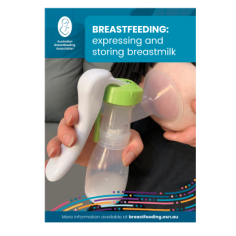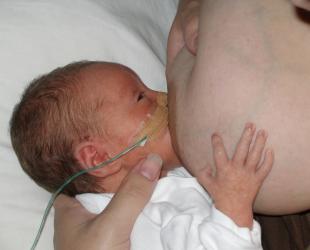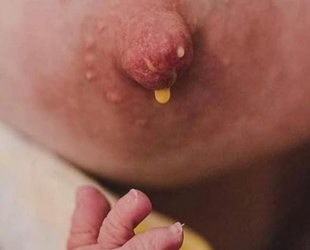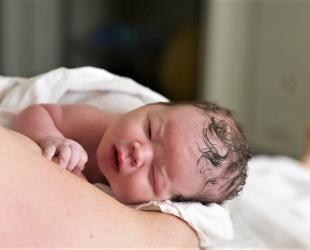Many babies with congenital heart disease can breastfeed
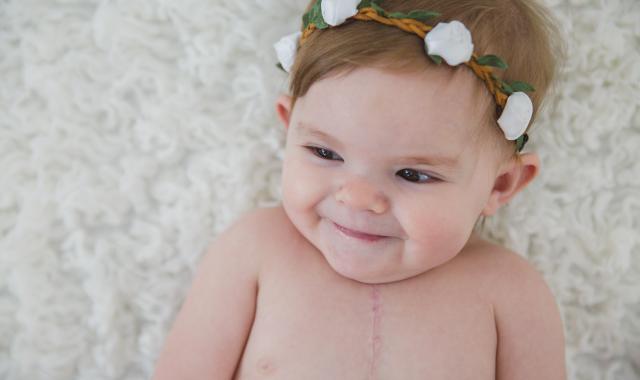
Congratulations on your new baby! If your baby has a heart condition, you may be unsure and worried if breastfeeding will be possible. However, many babies with congenital heart disease (CHD) can successfully breastfeed, sometimes even after a heart transplant.
Breastmilk is nature's food for all babies. Breastfeeding your baby is much more than nutrition. It provides immune protection, skin-to-skin contact, stimulation of all the baby's senses and much more.
Every child with a heart condition is unique in the type, extent, and limitations of their condition. Both breast and bottle feeding can be difficult for some babies due to their conditions. Some babies will need to be supplemented with either breastmilk or formula via nasogastric tubing. This doesn't mean you will need to stop breastfeeding. Many babies can be breastfed while being fed via a nasogastric tube.
If your baby has difficulties breastfeeding at first, persistence and time will often help you both to learn. Many babies need extra help to breastfeed. Keep expressing and feeding your baby breastmilk, while you teach them how to breastfeed with the help of a skilled lactation consultant.
If your baby is born prematurely, our booklet, Breastfeeding: your premature baby, may be helpful. It contains detailed and up-to-date information, plus mothers' comments and stories, photos and suggestions.
When your baby is born
In the first hour or two after your heart baby is born, the foetal circulation is still adapting to the new environment. This is an opportunity for you to hold your baby skin-to-skin and breastfeed if your baby is able. Many health checks such as ‘Apgar’ scoring can be performed with your baby on your chest. Your baby is likely to be cared for by a team of health professionals so you and your partner (or support person) may need to remind them of your wishes about breastfeeding.
As foetal circulation ceases and post-birth circulation sets in, medical staff may need to take your baby away for special care. This is difficult for any mother, but it is reassuring that you can still provide colostrum (first milk) and later breastmilk to your baby.
The first breastfeeds
Human babies, including those with heart conditions, are born with the instinctive ability to get themselves to the breast and to attach themselves correctly, with their mother's support. Spending one-on-one, skin-to-skin time with your baby when you are learning to breastfeed will help these 'baby-led attachment' instincts to work.
There are a few positions you may like to try to help your baby attach.
-
Baby-led attachment will allow your baby to move from skin-to-skin on your chest to find your breast.
-
With the cradle hold, your baby is lying on their side across your lap, their chest facing yours, their lower arm around your waist. In this position your baby doesn't have to turn their head to grasp the nipple. Some mums use a sling to hold their baby's body in a C-shape keeping their head and bottom tucked in. This may be particularly helpful after surgery where your baby will require additional body support. It might also help to support your baby's shoulder blades as they feed.
-
You may like to use the 'underarm hold'. Put a pillow at your side and another pillow across it and your lap. Rest your baby's bottom on the first pillow and support their back on your forearm while you cradle baby's head in your hand. You can try different feeding positions, until you find one that suits you both.
Some babies may have trouble coordinating their sucking, swallowing and breathing and may gulp as they feed. Many heart babies tire quickly but breastfeeding is often still easier for these babies than bottle feeding.
If your baby is having trouble sucking correctly, contact a lactation consultant, child health nurse, ABA breastfeeding counsellor or your doctor. There are techniques such as cup-feeding and various lactation aids which may be helpful.
A good knowledge of how breastfeeding works will help you establish it more easily.
If your baby can't breastfeed
Sometimes, due to your baby's condition, it may be a while before you experience putting your little one to the breast. But any time you can spend touching your baby, holding them skin-to-skin and bonding is beneficial to both of you.
The importance of support
You may find it helpful to speak with an ABA counsellor, a lactation consultant or your child health nurse for support as you and your baby learn to breastfeed. They may be able to put you in contact with another mother who has breastfed a baby with a similar condition.
Heartkids is an organisation with branches in each state. They offer phone and in-hospital support as well as special events to support families with a child with CHD. Your doctor will also be able to provide you with information about early intervention programs in your area.
Stories from other mums
[Breastfeeding] was the one, solitary thing I could do for my baby - his life was literally in the hands of everyone else and I had no control.
It is reassuring to talk to other mums and hear they were going through similar challenges. Sometimes you feel like you’re going crazy, and perhaps you are, but it’s nice to know you’re not alone.
“When Ben was not even a week old he was in an extremely critical and precarious condition. Due to this I was delaying going to pump and when I did pump I was doing a quick job as I didn’t want to be pumping if Ben crashed. The nurses in the Paediatric Intensive Care Unit (PICU) offered to bring a hospital pump and set it up next to Ben’s bed for me so I didn’t have to leave his side. They valued that I was making food for Ben even if he wasn’t able to use it yet and it also gave me hope that they believed he could pull through and might need it one day.”
She was crook and therefore didn't feel like feeding. It was 4 weeks till she was well enough for open heart surgery. My milk machines started to falter but with a prescription for Domperidone and a helpful lactation consultant we got there in the end. I still remember sitting in hospital, and her asking if she could touch my boobs so that she could show me how to massage them. Just the laugh I got from that alone helped ease my stress and get things flowing again. I left the hospital with 23 litres of expressed breastmilk (EBM).
We went home a week later with the plan of 10minutes on the breast and the rest through the nasogastric tube. Four days after being home we went back to hospital as Ethan was breathing funny. The doctors did tests to check everything and it ended up being his NG tube irritating his throat so it was taken out and we were put on the ward for another night, and overnight. Ethan breastfed like a champ!!
Our little warrior was born 29th April. He thrived and fed so well for the 11 days we had him home from hospital. Sadly, my instincts told me something was wrong and we took Logan back ... we stayed in hospital overnight, he still fed well but the next morning Logan went into cardiac arrest. We lost our beloved little man on the 15th June.
After we lost Logan a friend of mine tagged me in Human Milk for Human Babies page on Facebook because she knew I was passionate about our breastfeeding journey and had a lot frozen. That lead me to post Logan's story and donate some of his leftover milk to a mother who could not breastfeed. The breastfeeding journey we had was beautiful and I've since had jewellery made from Logan's breastmilk.
The information on this website does not replace advice from your health care provider.
© Australian Breastfeeding Association April 2022
1. Owens, B. (2002). Breastfeeding an infant after heart transplant surgery. Journal of Human Lactation, 18(1), 53-55. doi: 10.1177/089033440201800109
2. Leggat. S. (2011). Childhood Heart Disease in Australia – Current Practices and Future Needs. Sourced from: https://www.heartkids.org.au/wp-content/uploads/2012/01/White_Paper_A4_M...
3. Khan Academy (2012). Baby circulation right after birth - Circulatory system physiology. Sourced from: www.youtube.com/watch?v=jFn0dyU5wUw
4. Allen, H. D., & Ovid. (2013;2015). Moss and Adams heart disease in infants, children, and adolescents: Including the fetus and young adult (8th ed.). Philadelphia: Wolters Kluwer Health/Lippincott Williams & Wilkins.
5. Marino, B. L., O'Brien, P., & LoRe, H. (1995). Oxygen saturations during breast and bottle feedings in infants with congenital heart disease. Journal of Pediatric Nursing, 10(6), 360-364. doi:10.1016/S0882-5963(05)80033-8
6. Daymont, C., Neal, A., Prosnitz, A., & Cohen, M. S. (2013). Growth in children with congenital heart disease. Pediatrics, 131(1), e236. doi:10.1542/peds.2012-1157
7. Altaweli, R., & Roberts, J. (2010). Maternal--infant bonding: a concept analysis. British Journal of Midwifery, 18(9), 552-559.
More resources for you
If your baby is premature
Evidence-based info and practical tips
Breastfeeding: your premature baby
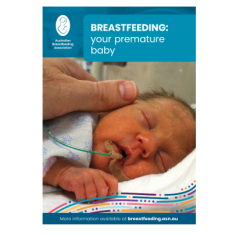
If you need to express
All the tips you need in one convenient booklet
Breastfeeding: expressing and storing breastmilk
